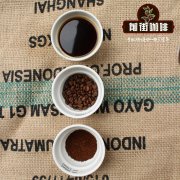Coffee bean moisture content knowledge how coffee bean moisture content affects coffee roasting

Professional coffee knowledge exchange more coffee bean information please follow the coffee workshop (Wechat official account cafe_style)
In every stage of the coffee industry chain, the moisture content of raw beans must be reduced to avoid defects and defects caused by moldy raw beans. Proper preservation can even improve the value of raw beans. Ensuring proper drying of beans is important to optimize their quality potential and minimize the possibility of problems.
The role closest to the end of the supply chain, the bean baker, has two tasks to control moisture content. On the one hand, they must maintain the moisture content of specific batches of raw beans within a precise range in order to maintain quality standards. They must keep the moisture content of coffee within this range and hope that raw beans will not be stored for more than a year, otherwise they will become old beans.
On the other hand, in a few minutes, the bean dryer applied high temperature and high pressure to drive the last remaining moisture out of the beans. In these few minutes, the coffee will be exposed to a lot of energy, which determines whether the coffee is successfully presented.
Is there an ideal moisture content?
There is no official standard for the ideal moisture content of raw beans, although the International Coffee Organization ICO recommends 11% as the standard. However, it is generally believed that 10-12% is a reasonable range. Any raw beans less than 10% may lead to a decline in coffee quality, while a higher moisture content may pose a risk of mold breeding.
However, the humidity of coffee is not static. Although the drying process in the producing area before export has greatly improved the stability of beans, the change in water content still exists. Environmental factors, such as particularly humid or hot places, are common causes of this situation.
Roast coffee with high / low moisture content
There are many factors in the baking process, and it is difficult to define the baking result through only one factor, such as water content. However, through a solid grasp of the basic principles of the baking process, coupled with accurate and consistent moisture content readings, we can clearly judge what baking techniques should be used and develop our own response process.
The beginning of the baking process involves accumulating enough heat and pressure in the bean baking machine to remove moisture from the beans at the beginning of the baking process. Due to the lack of better terminology, this stage is often referred to as "dehydration." No really important chemical reaction takes place at this stage; on the contrary, when the moisture is expelled, the pressure in the pot begins to increase, creating the conditions needed to bake the coffee. "
If you want to bake coffee with a high moisture content, you need to apply more heat at this stage. There are three options: preheat at a higher temperature (but do not scorch the outer layer of the coffee beans), use a higher temperature during the dehydration stage, or extend the dehydration period.
But there are still some ways to explore, and if your goal is to achieve consistency in dehydration time, a higher temperature preheating boiler is recommended at first. "if the beans have a high moisture content, the more calories they can retain and the better the heat transfer, so they can be baked with more heat at the beginning. "
Important Notice :
前街咖啡 FrontStreet Coffee has moved to new addredd:
FrontStreet Coffee Address: 315,Donghua East Road,GuangZhou
Tel:020 38364473
- Prev

How long is the general shelf life of coffee? how to prolong the shelf life of coffee?
Professional coffee knowledge exchange more coffee bean information Please follow the coffee workshop (Wechat official account cafe_style) Bean bakers will carefully observe the characteristics of raw beans, through the cup test to ensure the quality of the sample, and then can find out the best roasting method for this bean, try many ways to find out how to lead to the best flavor of this coffee. Roasted coffee is susceptible to many factors.
- Next

What do you mean by seasonal coffee beans? The importance of fresh coffee beans in this season
Professional coffee knowledge exchange more coffee bean information please follow the coffee workshop (Wechat official account cafe_style) Why coffee is in season or out of season? Coffee is a kind of food, and all food will go bad at a certain point in time. It depends on the processing (mainly the coffee drying process) and the storage of raw coffee beans. According to the condition of the bean itself and environmental factors, it can
Related
- Beginners will see the "Coffee pull flower" guide!
- What is the difference between ice blog purified milk and ordinary milk coffee?
- Why is the Philippines the largest producer of crops in Liberia?
- For coffee extraction, should the fine powder be retained?
- How does extracted espresso fill pressed powder? How much strength does it take to press the powder?
- How to make jasmine cold extract coffee? Is the jasmine + latte good?
- Will this little toy really make the coffee taste better? How does Lily Drip affect coffee extraction?
- Will the action of slapping the filter cup also affect coffee extraction?
- What's the difference between powder-to-water ratio and powder-to-liquid ratio?
- What is the Ethiopian local species? What does it have to do with Heirloom native species?

